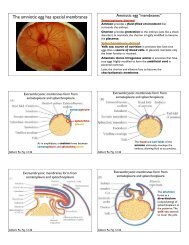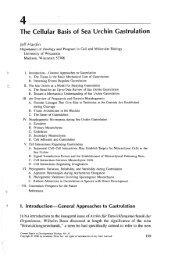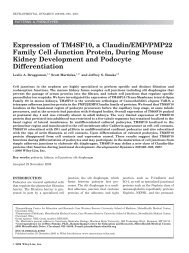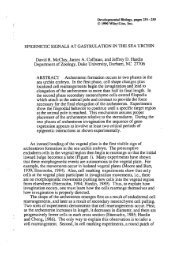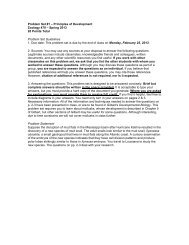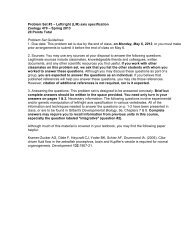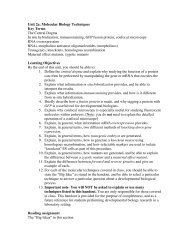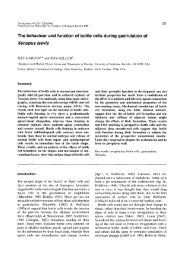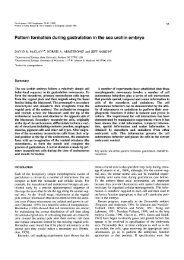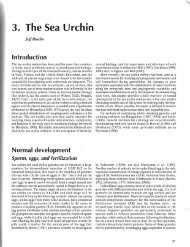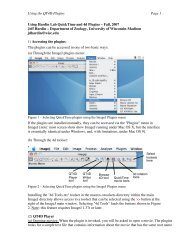WOC 6e Guide to Microscopy
WOC 6e Guide to Microscopy
WOC 6e Guide to Microscopy
Create successful ePaper yourself
Turn your PDF publications into a flip-book with our unique Google optimized e-Paper software.
RADIOISOTOPES AND ANTIBODIES CAN LOCALIZE<br />
MOLECULES IN ELECTRON MICROGRAPHS<br />
In our discussion of light microscopy, we described how<br />
microscopic au<strong>to</strong>radiography can be used <strong>to</strong> locate radioactive<br />
molecules inside cells. Au<strong>to</strong>radiography can also be<br />
applied <strong>to</strong> transmission electron microscopy, with only<br />
minor differences. For the TEM, the specimen containing the<br />
radioactively labeled compounds is simply examined in<br />
ultrathin sections on copper specimen grids instead of in<br />
thin sections on glass slides.<br />
We also described how fluorescently labeled antibodies<br />
can be used in conjunction with light microscopy <strong>to</strong> locate<br />
specific cellular components. Antibodies are likewise used in<br />
the electron microscopic technique called immunoelectron<br />
microscopy (immunoEM); fluorescence cannot be seen in<br />
the electron microscope, so antibodies are instead visualized<br />
by linking them <strong>to</strong> substances that are electron dense and<br />
therefore visible as opaque dots. One of the most common<br />
approaches is <strong>to</strong> couple antibody molecules <strong>to</strong> colloidal gold<br />
particles. When ultrathin tissue sections are stained with<br />
gold-labeled antibodies directed against various proteins,<br />
electron microscopy can reveal the subcellular location of<br />
these proteins with great precision (Figure A-29).<br />
CORRELATIVE MICROSCOPY CAN BE USED<br />
TO BRIDGE THE GAP BETWEEN LIGHT<br />
AND ELECTRON MICROSCOPY<br />
Immunostaining of fixed specimens and the imaging of living<br />
cells expressing proteins tagged with GFP are powerful <strong>to</strong>ols<br />
in the cell biologist’s arsenal, because they provide important<br />
information about the location of cellular components.<br />
Figure A-30 Correlative microscopy. (Left)<br />
A thin section through the pharynx (a muscular<br />
feeding structure) of an adult C. elegans (a<br />
nema<strong>to</strong>de worm) visualized using confocal<br />
microscopy. The green signal is a protein<br />
tagged with the Green Fluorescent Protein<br />
A-22 Appendix Principles and Techniques of <strong>Microscopy</strong><br />
(GFP) expressed at junctions between epithelial<br />
cells in the pharynx. The red is a colorized<br />
image of the light reflected from the section.<br />
(Right) The same section after processing for<br />
immunoEM, using an antibody that recognizes<br />
GFP. The gold particles localize <strong>to</strong> the same<br />
0.25 m<br />
Figure A-29 The Use of Gold-Labeled Antibodies in Electron<br />
<strong>Microscopy</strong>. Cells of the bacterium E. coli were stained with goldlabeled<br />
antibodies directed against a plasma membrane protein.<br />
The small dark granules distributed around the periphery of the<br />
cell are the gold-labeled antibody molecules.<br />
Because the wavelength of visible light is long, however,<br />
optical microscopy has inherent limits. Conversely, transmission<br />
electron microscopy provides incredibly detailed views of<br />
cells, but the cells must be chemically fixed or rapidly frozen<br />
prior <strong>to</strong> processing them for TEM. A powerful approach that<br />
unites these ways of examining cellular structures is<br />
correlative microscopy. In correlative microscopy, dynamic<br />
images of a cell are acquired using the light microscope, often<br />
using antibodies and/or GFP. The very same cell is then<br />
processed and viewed using EM. Commonly, immunoEM is<br />
used <strong>to</strong> determine where a protein is found at very high resolution<br />
(Figure A-30). Correlative microscopy thus bridges the<br />
0.5 m<br />
regions as the fluorescent signal. A higher<br />
magnification view (inset) shows where the<br />
gold particles localize relative <strong>to</strong> junctions<br />
between cells (TEM).



